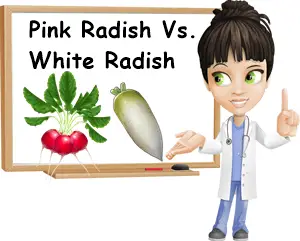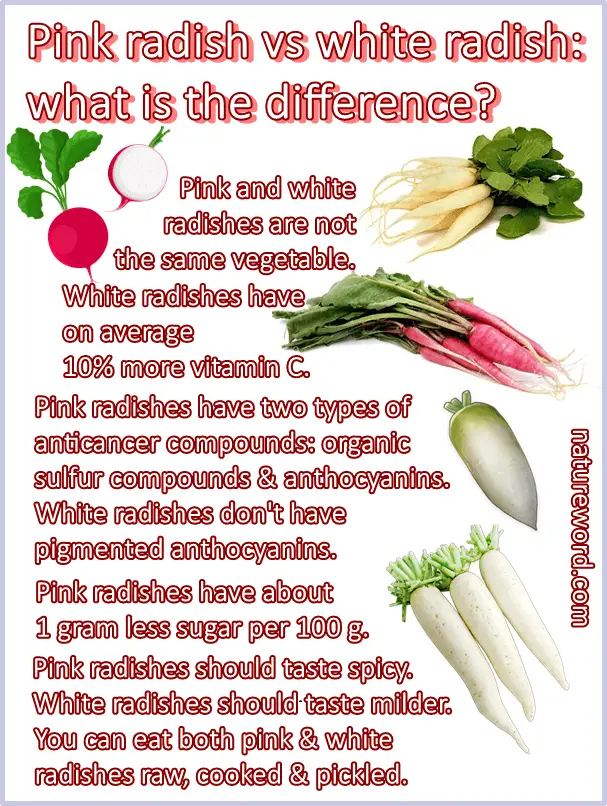What is the difference between white and pink radishes? Are white radishes healthier than pink radishes or is it the other way around? Are there more vitamins in pink radishes vs white? Are there more benefits to eating pink vs white radishes? Which would you choose between white and pink radishes?
Pink radish vs white radish: differences
What types of radish are pink and white radishes?
Pink radishes are root vegetables in the cabbage or mustard family and are known by the scientific name Raphanus raphanistrum sativus. White radishes are root vegetables in the cabbage or mustard family and are known by the scientific name Raphanus sativus longipinnatus. They are essentially two different types of radishes, with a different appearance, taste, but fairly similar nutrition and benefits for health.
Discover the top 13 benefits of eating pink radishes.

When are pink radishes vs white radishes in season?
Pink radishes are officially classified as spring and summer radishes because they were originally in season in spring and summer. Pink radishes were cultivated early spring for a mid-season or late-spring harvest, and again in mid-summer for a late-summer to early fall harvest.
By comparison, white radishes are classified as winter radishes because they were originally in season winter through early spring. White radishes were cultivated late fall to early winter, and harvested winter through spring.
However, both types of radish are currently being cultivated extensively, in both hemispheres which has made them become available continuously throughout the year as off season foods, despite being naturally in season at different times of the year.
Pink radish vs white radish: appearance
What do pink radishes look like?
For the most part, pink radishes have pink, pink-red or red-purple skin, and crisp white flesh, sometimes tinged with pink, red or red-purple near the skin. However, there are some varieties of pink radish such as the watermelon radish which has white and light green skin and watermelon pink flesh, tinged with white here and there. Pink radishes are usually either globular in shape, or long and tapering like a carrot or parsnip.
Pink radishes such as the watermelon radish can sometimes be mistaken for winter radishes if they are either completely white on the outside, or white with pale green. Pink-red radishes that grow an elongated tapering root resembling carrots are sometimes mistaken for actual carrots, such as red carrots.

What do white radishes look like?
White radishes typically have crisp white skin, sometimes tinged with light green at the top where exposure to sunlight may have occurred during the growth of the root. The flesh is also either completely white or, more rarely, white with the occasional green tinge. For the most part, white radishes are long and tapering, like a carrot, either slim and long or short and stout, or turnip-shaped.
While white radish varieties are usually a lot larger than pink radishes, they can be harvested early into the growing season when they very small in size. You can mistake a young white radish for a watermelon radish that is completely white or white tinged with green. Also, purple variants have been developed from white radishes, such as the purple Daikon radish which is either a pale purple on the outside, or pale purple tinged with white. If harvested early in the growing season when it’s still small, it can be mistaken for a red-purple radish.
Pink radish vs white radish taste
Pink radishes should taste quite spicy (ideally), with a pleasant freshness and crunch to them and sulfurous flavors specific to cabbage family vegetables. By comparison, white radishes should be crisp and juicy, but more mild-tasting, faintly sweet even and only very slightly pungent. Overall, the pink radish should taste more pungent and spicy than the white radish.
However, growing conditions impact taste a lot. For example, drought will make white radishes extremely pungent. Older radishes of both varieties will also be more pungent than younger ones, and also tougher or woodier in texture. White radishes can even taste sweet if allowed to overwinter in the field. Also, some roots can even taste bland under certain conditions.
Pink radish vs white radish: nutrition
In terms of nutrition, there is little difference between pink and white radishes which is understandable considering they are the same type of vegetable. Differences in nutritional profile between pink and white radishes are in the range of 1% of daily values per 100 grams. One major exception is vitamin C: white radishes have roughly 10% more vitamin C per 100 grams than pink radishes. Also, white radishes have, on average, 1 more gram of sugar per 100 grams vs pink.
Pink radish vs white radish: benefits and side effects
- Pink and white radishes are very low in calories which makes them good for weight loss diets.
- Both pink and white radish varieties have small amounts of potassium, approximately 5% of daily values, and are a source of minor benefits for high blood pressure.
- White radishes are approximately 10% higher in vitamin C which makes them slightly better for immune system support and skin health.
- The glycemic index of pink and white radishes is low, between 15 and 30, which makes them both good for high blood sugar control and diabetes.
- Pink and white radish microgreens are also good for diabetes, with studies revealing they contain compounds with an ‘insulin-like effect’, improving insulin sensitivity and reducing blood sugar levels (source 2).
- Pickled pink radishes and pickled white radishes are prebiotic foods, feeding gut bacteria for better gut health, and contributing to existing gut bacteria populations, enriching gut microflora diversity.
- Eating all types of radishes helps relieve constipation.
- Radishes in general have anti-inflammatory and immune system modulating benefits.
- Both pink and white radishes have anticancer components: both colors have organic sulfur compounds with scientifically proven anticancer activity against a number of different cancers, while pink radishes also have pigmented anthocyanin antioxidants with similar scientifically demonstrated anticancer effects.
- Neither radish color is a source of important side effects.
